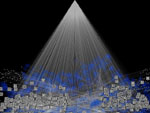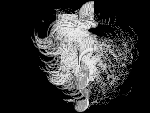

 |
|||||||||||||||||||||||||||||||
|
| |||||||||||||||||||||||||||||||
|
STATEMENT: "what you move is what you get" "The pieces on www.re-move.org are an attempt to articulate mathematical and natural principles below a visual surface in an enjoyable and sometimes playful way. People should be able to get their own ideas about the pieces and involve themselves without having any preconception of how to watch or how to "use" the pieces - that's why there are no instructions or any guidelines. Depending of the used formulas and also depending on who is watching/playing around, the results of the created images and/or sounds will always be different - in that sense, the user can also be seen as an additional random-factor in the code which can help to create a more or less "organic" result." (lia, July 2001) With Re-move, Lia gives us ten interfaces that present forms and sounds for the user to modify, transform, fiddle with at the whim of his mouse, either by clicking or by dragging it across the screen. The result consists less of a finished "work" than of aleatory visual and audio events, always different and always changeable. The title of the work, Re-move, underscores the permanent redistribution of forms in works that are always to be renewed. Art work assisted by a mathematical model is nothing new. In antiquity, well before the invention of computers, models allowing for the application of mathematical formulas, subject to combination, manipulation, transformation, and interpretation, and in view of an outcome not necessarily (although always somewhat) predictable, were implemented in music and architecture, in particular.1 A mathematical model always comprises four components: vocabulary, which corresponds to the list of terms or elements that will be used and related by way of a grammar, which places on their potentially infinite combination certain rules that guide and limit the possibilities; selection, that is, the choice of using certain elements of the vocabulary ordered according to certain rules, following the context of utterance or production; interpretation, finally, which analyzes and applies the resulting combinations. Naturally, this interpretation will be more or less open, depending on the level of determination invested in the combined elements to begin with: the component terms in the vocabulary of a natural language, for example, are more ambiguous, and therefore more likely to give rise to multiple interpretations than those of a formalized language; on the contrary, a model used to combine forms and even sounds to produce "artistic" output may allow greater freedom to user and performer alike. But such models must, from the outset, be rich enough at the vocabulary level and in combinatory possibilities to allow for "interesting" results, from an artistic point of view. What is precisely "interesting" in Re-move, besides the formal beauty of visual arrangements on the screen, is this tension between chance and necessity that leads the user to consider his own role in their production. This tension is possible here precisely because the "vocabulary" and "grammar" are never explicit. The visitor indeed has, or thinks that he has the possibility of selecting one or the other graphical element, the choice of "launching" or re-launching such and such a motif, of dragging forms one way and the other with his mouse, but, at the same time, these "works" (if one can use the term to describe the ephemeral creations or, rather, re-creations that play out on the screen before his eyes) preserve an aspect of independence and ineluctability that ensures their remaining out of the user's control. The work of art here is less an object than it is a meeting place between the code and the visitor, or rather a place where the code incorporates the visitor in its web and in its play, like one more factor likely to enrich it and to refine its complexity still further.
Anne-Marie Boisvert NOTES: 1- see John Lansdown, Centre for Electronic Arts, Middlesex University, Artificial creativity:An algorithmic approach to art |
||||||||||||||||||||||||||||||

